|
An Article By
Jerry L. Boyle |
| The Luger story has been told many, many times. From the evolution of the Borchardt
pistol, through the transition to Georg Luger’s own Pistole Parabellum, through two
World Wars and beyond, the Luger legend lives on. |
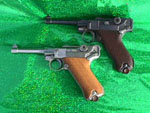
In 1923, Stoeger, Inc. obtained the American patent for the "Luger" name
for the import of German-built parabellum pistols into the United States. The 1923
commercial models, in .30 Luger and 9mm, and with barrel lengths from 3 *" to
24" were the first pistols to bear the name "Luger", roll stamped
on the right side of the receiver. Stoeger has retained the rights to the "Luger"
name. Over the past seven decades, Stoeger imported a number of different handguns
under the "Luger" mark including a .380 version, and an Erma-built .22
which only remotely resembled the original design.
In 1991, the Houston, Texas firm of Aimco, Inc. began making an all new remake of
the original Georg Luger design. At that time Mitchell Arms, Inc., under the "Mitchell"
name marketed Aimco’s "new" parabellum. Stoeger, Inc. bought the rights
to market the Texas-built pistols in 1994, and since that time the "Luger"
name again graces these fine toggle-action autoloaders. |
Stoeger’s current offering is named the "American Eagle" model. This refers
to the U.S. eagle roll-stamped above the chamber, closely resembling the eagle used
to mark the original pistols designated for U.S. import. The "American Eagle"
is available in 4" and 6" barrel lengths in 9mm Luger only.
The original luger pistols were hand-machined from solid billets of high-carbon steel.
They were then hand-fitted, hand-assembled, and hand-finished. Such labor-intensive
manufacturing in today’s world would require such a high retail price that no real
market would exist and prices would be in the outlandish realm with the one-of-a-kind
Martz
custom-built lugers. |
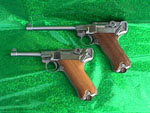
|
The Stoeger American Eagle is made from precision stainless steel investment castings;
CNC machined for a smooth, precise, fit and a corrosion-resistant finish. The stainless
is finished in a pleasing combination of high polish on most surfaces, with a non-reflective
gray sandblasted finish on the recessed areas of the frame and to the rear of the
toggle handles. For the more traditionally-minded, the American Eagle is also available
with a black finish applied over the stainless steel, to more closely resemble the
original rust-blued finish.
The two Stoeger American Eagle Lugers represented in this article were guns I purchased
in 1998. I was fascinated by the idea of being able to buy a "new" Luger
that I could shoot without the guilt I feel when I shoot an original. I am always
afraid I will break a part in any of my matched originals, and am very careful to
preserve them for their historical significance. Both of my American Eagles are in
the polished, natural stainless steel finish.
I ordered my 6" Navy Model new from Stoeger via a local dealer here in Indianapolis,
IN. It took my dealer several days, and many phone calls to distributors, to locate
a 6" Navy for me. He was told that mine was probably the only 6" at any
distributor in the U.S. at that time. |
| Never having spent over $600 for a newly manufactured handgun before, I wasn’t sure
quite what to expect. I was a bit surprised when it arrived in a generic black plastic
non-fitted foam lined case. I was more surprised that no manual accompanied the pistol
(Until I finally lifted the foam from the lid of the case and found it and the warranty
card….Oops.). It came with a single magazine, and the only accessory included was
a black molded open-ended box-like plastic device with a flange around one end. There
were no markings, nor indication of its intended use. At first, I thought it was
a wall-mounting bracket for the case. Having owned and shot several original lugers,
I eventually deduced that it was a magazine-loading tool, which slides down over
the body of the magazine and depresses the follower button on the right side of the
magazine. The pistol itself, however, was a beautiful sight to behold! Gleaming in
the lights of the store, it had the look of a large, beautifully polished piece of
fine jewelry! Other customers in the store stopped what they were doing to walk over
to see this pistol, which brings the same reactions every time I take it to the range.
And it shoots as great as it looks. More about that later. |

|
The story behind my 4" American Eagle was a bit more involved. I first saw it
in the gun case of a local pawn shop. I have picked up several great deals on original
milsurps at this shop, and check it frequently for new goodies. It was in unfired
condition, and had come in on a pawn. The gun had a $500 price tag on it, and frankly,
I was a bit (okay, a lot) over-extended on my gun budget. This was about 3 weeks
after taking possession of the above 6" Stoeger. So, I looked it over, held
it, fondled it, and tried to convince myself that I didn’t really NEED a 4",
and I went home. Over the next two weeks, I thought about that 4" a lot. After
all, I could CARRY a 4" more easily… and I have two teenage children (raised
on safe firearms use) who will be dividing up ol’ Dad’s guns someday. What a shame
it would be for them to not be able to EACH have a stainless Luger! Ok, I wanted
that gun. My wife and I re-figured the checkbook a few times, and went back to buy
it. And, it was gone… Gone! My 4" Luger was Gone. I asked the kid behind the
counter about it and learned that one of the other employees had bought it the day
before! Man! So close! So, I gave up on the idea of a 4" Stoeger. A couple of
weeks later, I walked into the store and saw Claude, the other counter guy, strutting
around the store with MY 4" Luger on his hip in a flapped "LUGER"
marked holster. I commented on the gun and he beamed and said, "Yeah, isn’t
it COOL?".
"Yeah, Claude. Pretty cool", I said, mumbling under my breath. I told Claude
that he just did beat me to it, and hoped he liked it as well as I liked my 6".
Another week passed. I stopped by the pawn shop to take another look at a Remington
Model 8 that I really didn’t have any burning desire for, and there was Claude again,
strutting around with the Luger on his hip. I asked him if he’d had a chance to shoot
it yet, and he said, "Yep, I put a whole magazine through it into the trap in
the back room to make sure it works! I wouldn’t CARRY a gun if I wasn’t sure it works!".
"Good thinking, Claude!", I said.
"Hey," said Claude, "You was the guy that wanted to buy this Luger,
weren’t you?"
"Yeah, back when it was still new….", O.K., I was fishing….
"Well, I been lookin’ at one of them little Kelmarks, this Luger’s kind of big
and bulky to tote around..."
Claude said, "What would you give me for it?"
Anyway, bottom line… I bought my almost new 4" Stoeger, with 2 magazines and
a "LUGER" flapped holster for $400. He kept the ammo from the magazines…
He had to have that to put in that Kelmark… Jeez!!! |
The holster, incidentally, is a padded black vinyl affair with a removable (velcro)
full flap and an attached pouch for an extra magazine. They are available from Stoeger
and the flap is embossed in white with the "LUGER" name in the same scroll
design that appears on the gun.
Let’s talk about the markings on the Stoegers. On the left side of the frame, on
the flat directly above the left grip panel is the word "LUGER", Stoeger’s
claim to fame, roll engraved in a pretty scroll design. The thumb safety is marked
with the word "SAFE" so it is covered when the lever is in the "up"
position. Unfortunately, the extractor is not marked "LOADED" or "GELADEN"
as the originals were. The top view of the pistol shows only the well-detailed American
Eagle stamp over the chamber. |
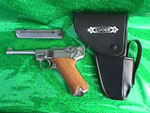
|
| The right side of the pistol tells the real story. On the receiver is the circular
Stoeger logo with the words "STOEGER IND. AMERICAN EAGLE" on the first
line, with "CAL. 9MM LUGER" below. On the frame, above the right grip panel,
is "AIMCO INC. HOUSTON TEXAS. Also on the frame, directly above the trigger,
is the serial number comprised of a letter and 4 digits on my examples. |
The magazines are stainless with plastic followers and plastic plugs shaped like
theoriginal wooden ones. The "American Eagle" bird is imprinted into both
of the magazine plugdished ends. Spare magazines are available from Stoeger for less
than $30 each.
The grip panels are very nicely checkered with a fine border (unlike originals which
were checkered to the very edges). The 6" Navy appears to have walnut panels,
while the 4" Army has a lighter, more orange color wood. The grips feel slightly
"thicker" than the originals. |
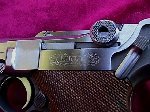
|
| Another slight deviation from the original design involves the stock-mounting lug
at the rear of the grip frame. While the lug is present on both guns, neither has
been grooved to allow a stock to be added. I am sure this is to keep Stoeger from
running astray of B.A.T.F. regulations concerning stocked pistols. The only other
picky little criticism is that both 4" and 6" models have fixed rear sights,
where the original 6" Navy models had an adjustable rear sight. Both feature
the tiny, v-notched original Army style rear sight. |
| Both of my Stoeger American Eagles are the most accurate 9mm pistols I have ever
fired. They are capable of producing much better groups at 25 yards than I can. While
I have not fired them from a machine rest, I can bench rest 1 * — 2" groups
with either pistol, and the sights are regulated very well to point of aim. Both
Stoegers, like their original counterparts, prefer a diet of stiff 9mm loads. The
original 9mm Parabellum ammo was considerably "hotter" than current American
factory loads. The toggle-action does a very good job of using up recoil energy,
and "hot" loads are the most reliable. The only ammunition advice in the
manual is to avoid the use of reloads, and that non-jacketed ammo can cause health
problems. I still need to contact Stoeger to see what their view is on using +P ammo. |
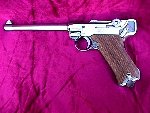
|
| For me, the Stoeger American Eagles fill a need in my collection. They allow me to
carry, shoot, discuss, and admire the Luger design without putting any of my original
DWM’s at risk. Do they have the same warm patina as a classic Imperial? Do they carry
that overwhelming sense of history as they nestle into you hand? No. But, I love
being able to allow a fellow shooter to handle and fire a Luger for the very first
time. And, I’ll admit it, I love the "OH, WOW!" reactions I get when I
slip one out of the case at the range and the sun glistens off the shiny finish in
that classic shape. Georg Luger may have designed "The Most Elegant Killing
Machine", but Stoeger has made sure the tradition will live on into the 21st
Century! |
|